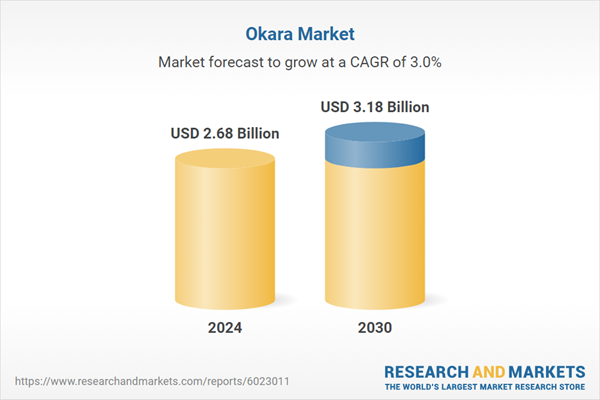Speak directly to the analyst to clarify any post sales queries you may have.
10% Free customizationThis report comes with 10% free customization, enabling you to add data that meets your specific business needs.
With consumers seeking alternatives to animal-based foods due to health, environmental, and ethical concerns, okara is emerging as a functional ingredient in a wide range of food categories including snacks, baked goods, meat alternatives, and beverages. Moreover, as food producers aim to reduce waste and promote sustainability, the use of okara aligns well with zero-waste and clean-label initiatives. This positions okara as a valuable component in the growing plant-based food industry.
Key Market Drivers
Growing Vegan Population
The increasing adoption of vegan lifestyles is a major contributor to the expansion of the global okara market. A rising number of consumers are embracing plant-based diets to support health, ethical concerns about animal welfare, and environmental sustainability. Okara, being free from animal products, is ideally suited for vegan consumption. It provides an excellent source of plant-based protein and fiber, making it a sought-after ingredient in vegan-friendly food innovations. Additionally, it serves as a sustainable solution by repurposing soy production byproducts, further appealing to eco-conscious consumers. For example, in India, millions follow a vegan lifestyle, and this population is growing steadily, presenting strong potential for okara-based foods in the region.Key Market Challenges
Lack of Standardization
A significant challenge for the okara market is the absence of standardized processing methods and quality control. The composition of okara can vary based on factors such as production techniques, soy variety, and storage conditions. This inconsistency creates issues for manufacturers seeking uniformity in texture, moisture levels, and nutritional profiles. The lack of uniformity complicates its integration into large-scale food production and discourages investment in product development. Moreover, without industry-wide standards, it becomes difficult to meet regulatory requirements and ensure product safety and consistency. Establishing quality benchmarks and processing protocols is essential for the market to scale and gain broader acceptance among food producers.Key Market Trends
Growing Demand for Non-Dairy Drinks
The increasing consumer shift towards non-dairy beverages is creating new opportunities for okara utilization. With rising demand for soy milk and other plant-based drinks, the production of okara is also increasing. Instead of discarding this nutrient-rich byproduct, companies are now repurposing it into new beverage innovations. For instance, Singapore-based start-up Soynergy is converting okara into fermented non-dairy drinks using probiotics and enzymes, reflecting the zero-waste trend. Given its rich content of dietary fiber and amino acids, okara is becoming a valuable resource for functional beverages and health-oriented food products. As the non-dairy category continues to grow, okara-based drink innovations are expected to contribute meaningfully to market development.Key Players Profiled in this Okara Market Report
- Fuji Oil Holdings Inc.
- Otoufu Factory Ishikawa Co., Ltd.
- Sunopta Inc.
- Satonoyuki Foods Co., Ltd.
- Dao Foods International, Inc. (Shanghai Protain)
- Kikkoman Corporation
- Renewal Mill
- Aloha Tofu Factory
Report Scope:
In this report, the Global Okara Market has been segmented into the following categories, in addition to the industry trends which have also been detailed below:Okara Market, by Product Type:
- Bakery
- Noodles
- Snacks
- Meat Substitutes
- Others
Okara Market, by End User:
- Household
- Food & Beverage Industry
Okara Market, by Region:
- North America
- United States
- Canada
- Mexico
- Asia-Pacific
- China
- Japan
- Indonesia
- South Korea
- India
- Europe
- France
- United Kingdom
- Italy
- Germany
- Spain
Competitive Landscape
Company Profiles: Detailed analysis of the major companies present in the Global Okara Market.Available Customizations:
With the given market data, the publisher offers customizations according to a company's specific needs. The following customization options are available for the report.Company Information
- Detailed analysis and profiling of additional market players (up to five).
This product will be delivered within 1-3 business days.
Table of Contents
Companies Mentioned
The leading companies profiled in this Okara market report include:- Fuji Oil Holdings Inc.
- Otoufu Factory Ishikawa Co., Ltd.
- Sunopta Inc.
- Satonoyuki Foods Co., Ltd.
- Dao Foods International, Inc. (Shanghai Protain)
- Kikkoman Corporation
- Renewal Mill
- Aloha Tofu Factory
Table Information
| Report Attribute | Details |
|---|---|
| No. of Pages | 188 |
| Published | May 2025 |
| Forecast Period | 2024 - 2030 |
| Estimated Market Value ( USD | $ 2.68 Billion |
| Forecasted Market Value ( USD | $ 3.18 Billion |
| Compound Annual Growth Rate | 3.0% |
| Regions Covered | Global |
| No. of Companies Mentioned | 9 |









